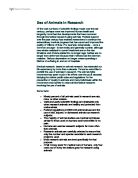The practice of metta (loving-kindness) towards all creatures is an integral part of Buddhism. An harmonious, peace-loving belief system would not condone killing animals even if it is for research.
‘Do not harm others. Just as you feel affection on seeing a dearly beloved person, so you should extend lovingkindness to all creatures.’ 1
An understanding of kamma helps Buddhists to be more loving towards living creatures. Ethically significant actions have consequences – for example, killing animals for research could cause a scientist to feel guilty. This guilt would be the karmic effect of the action. Siddhartha Gautama is said to have set a good example for gaining merit: he threw his leftover food in a river to feed the fish, and by the power of that merit he was saved from a disaster. Different types of Buddhism, particularly Tibetan, teach about rebirth. According to the Kukkuravatika Sutta, it is possible for humans to be reborn as animals – therefore animals must be treated with kindness
Other religions have views about using animals for research as well. Christians, for example, believe that God created the world, humankind and all other living things. Humans were created in God’s image and told to take care of and rule over other creatures.
‘Then God said, “Let us make human beings in our image and likeness. And let them rule over the fish in the sea and the birds in the sky, over the tame animals, over all the earth, and over all the small crawling animals on the earth.”’ 2
Some people might take this verse to mean that humans are allowed to do what they want with animals since they have power over them. However, it can also be taken as ‘looking after’ and ‘taking care’ of animals rather than simply ‘ruling over’ them. Animals, as God’s creatures, deserve to be treated with respect.
‘Scientists must abandon laboratories and factories of death.’ 1
Other monotheistic religions share such views. Islam teaches that everything is created by Allah, so mercy and compassion should be shown to animals. However, people may take the life of animals if it is for food or another useful purpose. If an animal is to be killed for a ‘useful purpose’ then it is important that it isn’t kept in poor conditions beforehand. This would be disrespectful and against the spirit of Islam.
‘If someone kills a sparrow for sport, the sparrow will cry out on the Day of Judgement, “O Lord! That person killed me for nothing! He did not kill me for any useful purpose!”’ 2
Scientists back up their use of animals for research purposes by claiming that they are used to develop new medicines that could save lives.
‘The benefits or successes of animal-based science are so widespread that it is hard to imagine any area of our lives that is unaffected by them.’ 3
If animals weren’t used for medical research, then we wouldn’t have nearly as many vaccines, and we wouldn’t be so aware of how certain drugs affect the human body. Some things are too risky to test on humans – small animals, however, are bred for the purpose. Although many animals are likely to be killed in medical research, numerous human lives will be saved because of it.
‘Animals are only used when the answers to scientific questions cannot be obtained in any other way. Broadly speaking, animals are used in research and testing when it is necessary to see what happens in the whole living body, but the use of human subjects would not be ethically acceptable.’ 4
After looking at different points of view, I can draw my own conclusion. Personally, I think that we should be allowed to kill animals for research – but only if we need to. If alternative methods are feasible then they should be used, although scientists have said that many other testing methods are not advanced enough. As a Christian, I believe that all beings were created by God – but humans are the most advanced, and human life has greater intrinsic value than animal life. We must respect other animals but, at the same time, we rule over them. If killing animals for research would be beneficial to humans then it needs to be done, as long as they are treated humanely and no animals are killed unnecessarily.
- The Buddha
- Genesis 1:26
- Pope John Paul II
- Hadith
- Animal Welfare Society and Bioethics Centre
-







